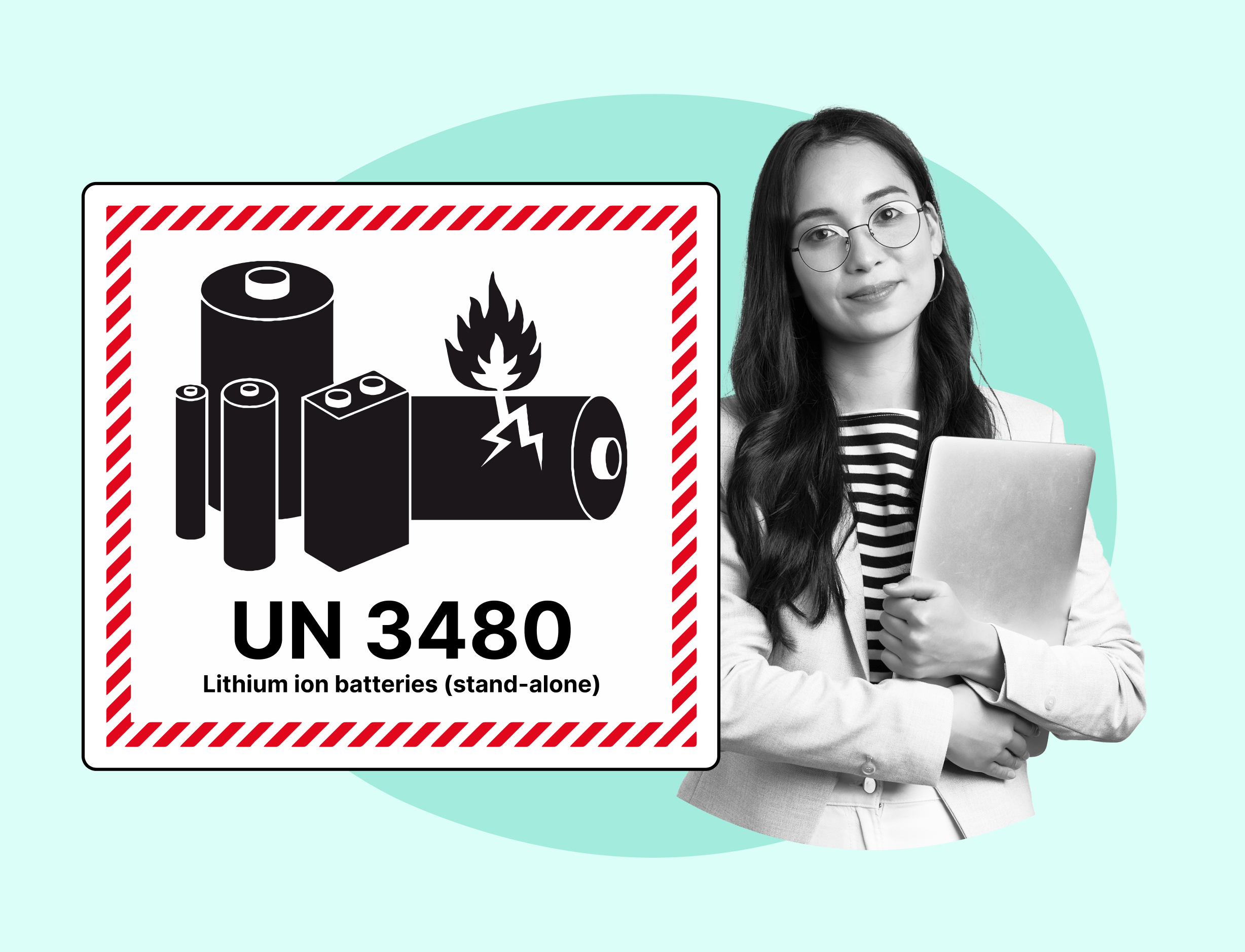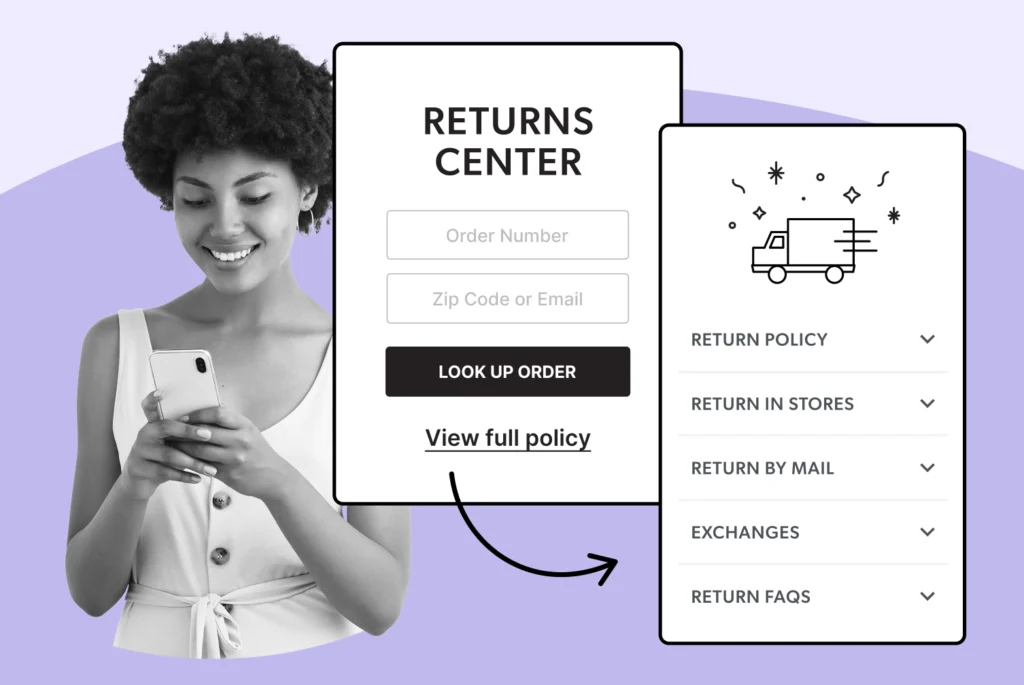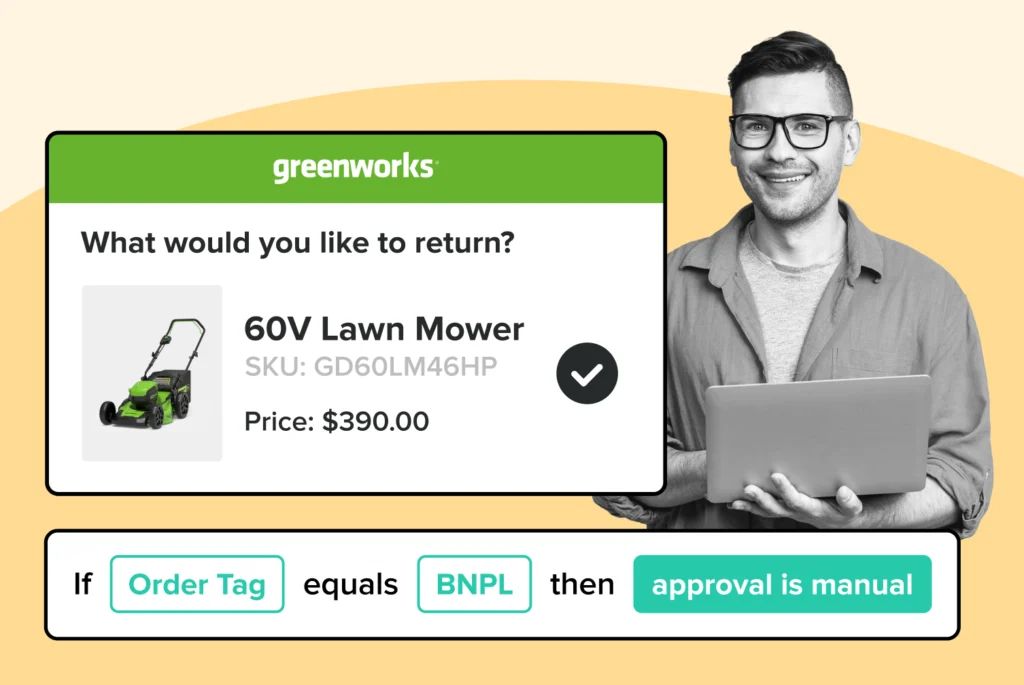
Minimizing Risk to Shopper Data in Ecommerce
Discover effective return policy page examples that can boost customer trust and satisfaction. Enhance your business strategy!
Shipping, Tracking & Notifications
Boost customer experience and reduce support tickets
Realtime order and shipment tracking
Proactive order and shipping notifications
AI-Enhanced Discounted Labels
Predictive pre-purchase estimated delivery dates
Self-Serivce branded order tracking
Effortless experience delivered
Identify and Resolve Order Issues
Realtime order and shipment tracking
Make returns profitable and delight customers
Flexibility to define any return destinations & conditions
Simplify returns for your customers and team
Incentivize exchanges over returns
Returns management made easy for your team
Returns management made easy for your team
Easy claims and smart upsells
Understand why your customers are returning
In-Store & Curbside Pickup
Unify the online and the in-store experience
Hassle-free pickup experience for customers
In-Store dashboard to keep operations streamlined
In-Store and Online orders unified
Drive foot-traffic to your stores
Shipping, Tracking & Notifications
Boost customer experience and reduce support tickets
Realtime order and shipment tracking
Proactive order and shipping notifications
AI-Enhanced Discounted Labels
Predictive pre-purchase estimated delivery dates
Self-Serivce branded order tracking
Effortless experience delivered
Identify and Resolve Order Issues
Realtime order and shipment tracking
Make returns profitable and delight customers
Flexibility to define any return destinations & conditions
Simplify returns for your customers and team
Incentivize exchanges over returns
Returns management made easy for your team
Returns management made easy for your team
Understand why your customers are returning
In-Store & Curbside Pickup
Unify the online and the in-store experience
Hassle-free pickup experience for customers
In-Store Dashboard to keep operations streamlined
In-Store and Online orders unified
Drive foot-traffic to your stores
Boost customer experience and reduce support tickets
Realtime order and shipment tracking
Proactive order and shipping notifications
AI-Enhanced Discounted Labels
Predictive pre-purchase estimated delivery dates
Self-Serivce branded order tracking
Effortless experience delivered
Make returns profitable and delight customers
Flexibility to define any return destinations & conditions
Simplify returns for your customers and team
Incentivize exchanges over returns
Returns management made easy for your team
Equip your team for precise return checks.
Easy claims and smart upsells
Understand why your customers are returning
Unify the online and the in-store experience
Hassle-free pickup experience for customers
In-Store Dashboard to keep operations streamlined
In-Store and Online orders unified
Drive foot-traffic to your stores
Find the answer to all your questions
Take a step by step trip through our functionality to see how we can improve your ecommerce processes.
Explore the most comon questions about WeSupply
Calculate the ROI that WeSupply can bring you
Read actionable articles on how to optimize your post-purchase experience and decrease support tickets
Get inspired by stories of how our customers implemented an effortless post-purchase experience
Wondering if WeSupply is a good fit for you? Read through our use cases to see how we can help you increase conversion & improve CX!
A Deep Dive into Top Companies' Order Tracking & Returns Strategy
Find the answer to all your questions
Explore the most comon questions about WeSupply
Calculate the ROI that WeSupply can bring you
Request a no strings attached review of your current shopping experience and missed conversion opportunities
Take a step by step trip through our functionality to see how we can improve your ecommerce processes.
Read actionable articles on how to optimize your post-purchase experience and decrease support tickets
Get inspired by stories of how our customers implemented an effortless post-purchase experience
A Deep Dive into Top Companies' Order Tracking & Returns Strategy
Wondering if WeSupply is a good fit for you? Read through our use cases to see how we can help you increase conversion & improve CX!

Shipping hazardous materials—commonly known as HazMat—might sound daunting, but it’s a crucial aspect of many eCommerce operations. You might picture HazMat as highly dangerous chemicals or explosive substances, but in reality, it includes far more everyday items than you might expect. Products like nail polish, perfume, and even certain batteries fall under the HazMat category. Surprised? You’re not alone. These items are classified as hazardous because they can pose risks during transport, such as leaks, spills, or even fires if not handled correctly. Just think about lithium batteries, which, despite being a staple in many electronics, have been known to catch fire when damaged or improperly packed.
Understanding what qualifies as HazMat is just the first step. Compliance is where things can get tricky, but it’s absolutely essential. Shipping dangerous goods without following the proper regulations can lead to hefty fines, legal trouble, or even accidents that put lives and property at risk. That’s why staying informed about HazMat regulations is not just good practice—it’s a necessity for any business that ships potentially hazardous products. In this guide, we’ll walk you through the latest rules, how to properly package and label HazMat items, and practical tips to ensure your business stays compliant and your shipments remain safe.
Navigating the world of hazardous materials, or hazmat, starts with understanding the different types of substances that fall under this category. These materials pose various risks to health, safety, and the environment during transportation, and are classified into nine distinct classes, each with its own specific shipping requirements and regulations.
Class 1: Explosives – This class includes items like fireworks and ammunition, which can cause explosions if not handled properly.
Class 2: Gases – This category covers both flammable and non-flammable gases, such as propane and oxygen, which can pose risks of fire or asphyxiation.
Class 3: Flammable Liquids – Common items like gasoline and paint fall into this class, requiring leak-proof containers to prevent spills and fires.
Class 4: Flammable Solids – Materials like matches and charcoal are included here, needing special packaging to prevent ignition.
Class 5: Oxidizing Substances and Organic Peroxides – Items such as hair dye and pool chemicals, which can cause or enhance the combustion of other materials, are part of this class.
Class 6: Toxic and Infectious Substances – This class includes pesticides and medical waste, which require secure containment to prevent exposure.
Class 7: Radioactive Materials – Medical isotopes and nuclear waste fall under this category, necessitating stringent packaging and handling protocols.
Class 8: Corrosives – Substances like sulfuric acid and sodium hydroxide, which can cause severe damage to living tissue and materials, are included here.
Class 9: Miscellaneous Hazardous Materials – This catch-all category includes items like dry ice and lithium batteries, which pose various risks but don’t fit neatly into the other classes.
Proper shipping of these materials involves adhering to hazmat regulations, including using appropriate packaging, labeling, and documentation to ensure safe transport and compliance with legal requirements.
When it comes to HazMat shipping, one of the first things to understand is how hazardous materials (HAZMAT) are classified. In the world of shipping and logistics, not all hazardous materials are created equal, and that’s why they’re grouped into nine distinct classes. These classes help identify the specific risks associated with each substance and determine how they should be handled, packaged, labeled, and transported.
The nine classes of hazardous materials range from the most volatile to the relatively less dangerous. Class 1 includes explosives—think fireworks and ammunition—while Class 2 covers gases, such as propane or compressed oxygen. Class 3 consists of flammable liquids like gasoline, alcohol, and some cleaning agents. Moving along, Class 4 encompasses flammable solids, such as matches or some types of magnesium. Class 5 deals with oxidizing substances and organic peroxides, while Class 6 covers toxic and infectious substances, including pesticides and certain medical waste. Radioactive materials fall under Class 7, while Class 8 is for corrosive substances like acids. Finally, Class 9 is the catch-all for miscellaneous dangerous goods, which might not fit neatly into the previous categories but still pose risks, like lithium batteries or environmentally hazardous substances.
Correctly classifying hazardous materials is more than just following a rule—it’s about ensuring safety at every step of the shipping process. Each class comes with its own set of regulations for packaging, labeling, and stowage. For example, lithium batteries, which fall under Class 9, require special packaging to prevent short circuits and are subject to labeling requirements that clearly indicate the risk of fire. Flammable liquids like alcohol (Class 3) need robust, leak-proof containers to prevent spills, while toxic substances (Class 6) require clear hazard labeling and secure containment to avoid exposure.
Classification also plays a crucial role in emergency response. Imagine a package containing lithium batteries catching fire during transit. Emergency responders need to know exactly what they’re dealing with to manage the situation effectively. If a package is misclassified—or worse, not labeled as hazardous at all—it can lead to delayed response times and increased risks to safety. Accurate classification ensures that all parties involved—from shippers and carriers to emergency teams—know how to handle the material safely, both during routine transport and in case of an incident.
In short, understanding the classification of hazardous materials is essential for any business shipping potentially risky items. It not only helps meet legal requirements but also ensures that everyone involved can respond appropriately if something goes wrong. Whether you’re shipping batteries, perfumes, or flammable liquids, getting the classification right is the first step toward safe and compliant shipping.
Staying on top of HazMat shipping regulations and regulatory requirements is crucial, especially with the recent updates for 2025. The new rules focus on improving safety and streamlining compliance, but they can feel a bit overwhelming if you’re not prepared. Let’s break down the key changes to help you navigate the new landscape.
The USPS has introduced stricter packaging rules, particularly for lithium batteries and other potentially hazardous items. Packaging now needs to be tougher and meet specific drop-test criteria, especially for surface-only shipments. Additionally, merchants must label HazMat packages with one of six product-specific service type codes (STCs) and include a clear “HazMat” indicator. Electronic files must be submitted to the USPS for data verification, and refunds for HazMat items have become more restrictive. The goal? Minimize risks during transit while ensuring accurate and safe handling.
On the international front, the Pipeline and Hazardous Materials Safety Administration (PHMSA) has aligned its standards with the 2025–2026 ICAO and IMDG Code for air and vessel transport. This move allows for more flexibility when shipping overseas but requires meticulous documentation to stay compliant. It’s all about harmonizing domestic and international regulations to facilitate safer global shipping.
Rail transport is also seeing changes. Beginning in June 2025, railroads are required to provide real-time train consist information during incidents. This means shippers need to update their documentation and emergency response plans to include real-time data for hazardous cargo. It’s a shift toward greater transparency and quicker response during accidents.
If your business involves cross-border shipments to Canada, take note: as of May 2025, certain older tank cars, like Class 111 and CPC-1232, can no longer transport flammable liquids. This regulation aims to enhance safety but might require you to invest in updated rail equipment or explore alternative transport options.
Lastly, keep an eye on proposed regulatory changes from PHMSA. The agency is considering adjustments that could impact tank car approvals, labeling standards, and training requirements. These proposals are not set in stone yet, but staying informed will help you prepare for potential future updates.
Navigating these changes might seem complex, but with the right strategies and up-to-date practices, your business can continue to ship HazMat items safely and efficiently.
In 2025, packaging standards for shipping hazardous materials got a serious upgrade to boost safety and prevent accidents. One of the biggest changes involves tougher rules around how materials, especially lithium and sodium-ion batteries, must be packaged. These batteries are tricky because they can overheat or catch fire if damaged, so the new rules require stronger, more protective packaging that can handle rough handling during transit.
One important aspect is the use of plastic drums for packaging dangerous liquids. The choice of drum material—such as steel, aluminum, or plastic—depends on the type of liquid being stored, underscoring the regulatory requirements associated with HAZMAT packaging.
For merchants using USPS, there’s now a clear focus on meeting specific drop-test criteria—meaning packages have to survive certain drops without breaking or leaking hazardous contents. This helps ensure that fragile or dangerous items don’t cause problems on their way to customers.
When choosing packaging, it’s important to consider the hazard class of your materials. For example, flammable liquids need leak-proof, durable containers, while corrosive substances might require special liners or double packaging. Picking the right packaging isn’t just about compliance—it’s about protecting your shipment, the people handling it, and the environment.
Overall, these updated packaging rules might feel like extra work, but they’re designed to make HazMat shipping safer and smoother for everyone involved.
Labeling and marking your HazMat shipments correctly is super important—not just to follow the rules but to keep everyone safe. The shipping label is crucial for compliance with safety regulations, as it indicates the nature of the goods being transported and informs carriers about potential dangers. In 2025, USPS introduced new requirements that include specific Service Type Codes (STCs) you need to use on your packages. These codes help USPS quickly identify the type of hazardous material inside, which speeds up handling and reduces mistakes. Plus, every HazMat package must have a clear “HazMat” marking on the label so it’s obvious at a glance.
Keep in mind, labeling requirements aren’t one-size-fits-all. Domestic shipments usually have different labeling rules compared to international ones, which follow guidelines like the ICAO Technical Instructions or IMDG Code. This means you need to adjust your labels depending on where your shipment is headed to ensure it meets the right standards.
For practical labeling, make sure all labels are durable, legible, and placed prominently on the package. Use the correct hazard class labels, include emergency contact info when required, and avoid overlapping or covering any markings. These small details can make a huge difference in compliance and safety, helping avoid delays, fines, or even dangerous accidents during transit. Staying on top of labeling means smoother shipments and peace of mind for everyone involved.
Getting your shipping papers right is a key step to smooth HazMat transport. You’ll need essential documents like Material Safety Data Sheets (MSDS) that explain the hazards of your materials, along with proper shipping names, hazard classes, and emergency contact information. These details aren’t just paperwork—they’re vital for everyone handling your shipment to stay safe and respond quickly if needed.
If you’re shipping via USPS, don’t forget about the electronic file submission (SSF) requirement. This means submitting your shipping info digitally before sending your package, helping USPS track and manage HazMat shipments better. Accuracy here is crucial—any mistakes or missing info can cause delays or penalties.
Keeping your records complete and precise ensures compliance with regulations and helps avoid costly fines or shipment rejections. When you prepare your paperwork thoroughly, it makes the entire shipping process safer and more efficient for everyone involved.
Simplify Returns for Your Customers and Support Team
Book a quick call with our experts to see how WeSupply can help you: simplify the Return experience with just a few clicks, reduce customer service calls and manual processing, notify your customer about their refund, automate returns and reduce user error.
When shipping hazardous materials, it’s important to understand that different carriers—like USPS, railroads, or international transport providers—each have their own specific rules. USPS, for example, has updated packaging and labeling requirements, while rail shipments now need real-time train consist information during incidents, which includes details about the cargo and emergency contacts.
Working closely with your carriers is key to making sure you meet all these requirements and keep shipments compliant. Before you send anything, take the time to verify that your carrier follows the latest regulations and understands your HazMat shipment’s specifics. This collaboration helps prevent costly delays, penalties, or safety issues.
Double-check carrier certifications, ask about their hazmat handling procedures, and ensure everyone’s on the same page. By staying proactive and communicating clearly, you can avoid surprises and keep your hazardous materials moving safely and smoothly.
Training programs are the backbone of safe and compliant HazMat shipping. Anyone involved in handling or transporting hazardous materials must complete DOT-approved training within 90 days of starting their role. This isn’t just a one-time thing—refresher courses every three years are required to keep everyone sharp on the latest rules and best practices.
Certification ensures your team knows how to package, label, and handle materials safely, reducing risks for accidents and fines. Beyond compliance, ongoing training helps build a culture of safety in your business where everyone feels confident and responsible. When your team is well-trained, shipping hazardous materials becomes smoother, safer, and less stressful for everyone involved.
Shipping hazardous materials comes with serious responsibilities, and failing to comply with strict regulations can lead to hefty fines—now ranging from hundreds to over $179,000 per violation. These penalties aren’t just numbers on paper; they can disrupt your business operations, damage your reputation, and even lead to bans on shipping hazardous goods altogether. Staying proactive by keeping up with the latest regulatory updates and investing in proper training can help you avoid these costly consequences. Monitoring changes and ensuring your team follows all rules means you’re not just protecting your business financially, but also safeguarding the safety of everyone involved in the shipping process. Compliance is truly the best way to stay ahead and keep your operations running smoothly.
Handling returns of hazardous materials requires special handling due to the potential dangers associated with these items, especially with USPS’s strict policies on refunds and returns for these items. Safety has to be the top priority—improper handling can lead to accidents or regulatory issues. Using specialized return management solutions can make this process much easier by customizing how you handle and track HazMat returns, ensuring everything stays compliant and safe. It’s also smart to have clear strategies in place to minimize risks, like inspecting returned items carefully and following proper packaging and labeling protocols. With the right tools and precautions, managing HazMat returns can be smoother and safer for both your business and your customers.
Handling returns for hazardous materials can feel like walking a tightrope—between strict regulations, safety concerns, and customer expectations, there’s zero room for error. That’s where WeSupply steps in to simplify the complex.
With WeSupply, you can confidently manage HazMat returns with features like:
✅ Custom Return Workflows – Build workflows that comply with federal and carrier-specific HazMat regulations.
✅ Smart Carrier Integration – Easily pair with carriers that support HazMat returns and generate compliant shipping labels.
✅ Inteliigent Dispositions – Route returns to internal HazMat handling teams or 3PLs for fast, safe processing.
✅ Return Visibility & Tracking – Keep both your team and your customers in the loop with real-time tracking—even on specialized HazMat returns.
Ready to take the stress out of hazardous returns? Let WeSupply handle the complexity—so you don’t have to. Book a demo and see it in action!
Combat inconvenience with proactivity & self service
Book a quick call with our experts to see how WeSupply can help you make returns easy for your customers with a beautiful, self-service solution that makes their experience easier while also providing new ways to lower costs and earn back revenue.
Shipping hazardous materials internationally means juggling different sets of rules, mainly the IMDG Code for sea transport and the ICAO Technical Instructions for air transportation. These global standards are designed to keep everyone safe, but they can differ from U.S. domestic regulations in important ways. That means you need to pay close attention to packaging, labeling, and documentation to meet both international and U.S. requirements. Properly marking your shipments and including all necessary paperwork not only ensures compliance but also helps avoid delays and fines at borders. Staying updated on these evolving rules and working closely with carriers familiar with international hazmat shipping will make crossing borders smoother and safer for your business.
Shipping hazardous materials comes with its own set of challenges, and even small mistakes can lead to significant consequences, including fines, penalties, and accidents. Here are some of the most common mistakes businesses make when shipping hazmat, and how to avoid them:
Improper Classification: Misclassifying hazardous materials can lead to incorrect packaging and labeling, increasing the risk of accidents. Always ensure materials are correctly classified according to their hazard class.
Incorrect Shipping Names and MSDS: Using improper shipping names or failing to include a Material Safety Data Sheet (MSDS) can result in non-compliance. Make sure all documentation is accurate and complete.
Inadequate Packaging: Using the wrong containers or insufficient cushioning can cause leaks or spills. Follow packaging requirements specific to the material’s hazard class, such as using leak-proof containers for flammable liquids.
Missing or Incorrect Labels: Hazmat shipping labels and placards are crucial for identifying risks. Ensure all labels are correct, legible, and prominently placed on the package.
Non-Compliance with Packaging Requirements: Each hazard class has specific packaging requirements. For example, flammable liquids need robust, leak-proof containers, while toxic substances require secure containment.
Inadequate Training: Personnel involved in shipping hazardous materials must be properly trained and certified. Regular training ensures everyone is up-to-date with the latest regulations and best practices.
Ignoring Emergency Response Protocols: Failing to follow emergency response protocols can exacerbate accidents. Always have clear procedures in place and ensure all staff are familiar with them.
Non-Compliance with Federal Regulations and USPS Rules: Staying compliant with federal regulations and USPS rules is essential. Regularly review and update your practices to align with the latest requirements.
Poor Tracking and Monitoring: Inadequate tracking of hazmat packages can lead to lost or mishandled shipments. Utilize USPS tracking and other monitoring tools to keep tabs on your shipments.
Avoiding these common mistakes involves ensuring regulatory compliance, using proper labeling and packaging, and providing adequate training and certification for all personnel involved in shipping hazardous materials. By doing so, you can minimize risks and ensure the safe and efficient transport of hazmat goods.
For ecommerce merchants shipping hazardous materials, staying compliant with applicable regulations doesn’t have to be overwhelming. Start by making sure your team gets solid, ongoing training so everyone understands the latest rules and best practices. Keep your documentation tight and accurate—proper shipping papers and emergency info are must-haves. Choosing the right packaging and labeling solutions tailored to your specific products will help you meet regulations and protect shipments. Partnering closely with experienced 3PLs and carriers who know hazmat requirements can ease the process and reduce risks. And finally, having a clear emergency response plan ready ensures you’re prepared if anything unexpected happens, keeping your team and shipments safe. With these strategies, compliance becomes manageable and your business stays on track.
Leveraging technology, especially when dealing with electronic devices containing lithium batteries, can really simplify and improve the way you handle hazmat shipping. Integrating returns management software specifically designed for hazardous products helps keep everything organized and ensures safe handling throughout the process. Automating your documentation and labeling reduces human errors, which are common pain points in hazmat shipping compliance. Plus, real-time tracking and reporting give you up-to-the-minute visibility, so you can quickly address any issues and stay confident that you’re meeting all regulations. Finally, using digital compliance tools to monitor regulatory changes means you’re always up to date without the hassle of manually tracking new rules. Embracing these technologies not only makes your operations smoother but also boosts safety and compliance.
To wrap things up, building a safe and compliant HazMat shipping strategy means staying on top of regulatory updates and putting practical tips into action—from proper packaging and labeling to thorough training and clear documentation. The key is to be proactive: regularly review your processes and stay prepared for any changes that might come down the pipeline. Regulations evolve, and staying informed helps you avoid costly penalties and keep everyone safe. That’s where WeSupply can help simplify the complex. With automated workflows that support special handling instructions, real-time tracking for full return visibility, and custom return rules that adapt to HazMat restrictions, WeSupply takes the guesswork out of compliance. Its branded return portal ensures customers are guided clearly through each step, while built-in documentation tools keep your team audit-ready. By leveraging tools like these, you can confidently navigate HazMat return challenges and keep your business running safely, smoothly, and efficiently.
The key updates include tougher USPS packaging requirements, increased fines for violations (up to over $238,000), new classifications for sodium-ion batteries, and real-time train consist information for rail shipments. These changes aim to enhance safety and compliance across all transport modes.
Make sure to use the correct hazard labels and markings specific to each regulation, like the USPS standards for domestic shipments and ICAO or IMDG codes for international shipments. Clear, accurate labeling helps handlers and emergency responders identify risks and handle materials safely.
All personnel must complete DOT-approved HazMat training within 90 days of employment and receive refresher training every three years. This training covers packaging, labeling, documentation, and safety procedures essential for regulatory compliance and safe shipping.
Yes! WeSupply makes HazMat returns easier and safer by allowing merchants to set custom return rules based on product type, category, or location—ensuring only eligible items are accepted. You can configure your return portal to flag HazMat items and guide customers through proper procedures, helping reduce compliance risks and avoid costly errors.
Yes, WeSupply does have an official Shopify App. You can download and begin to integrate it with your Shopify store.
Yes, WeSupply has an official extension for Magento. The WeSupply x Magento integration allows for automating order tracking experiences, reducing customer inquiries, automating shipping email and SMS notifications, and providing a fully branded order tracking experience
Yes, WeSupply has an official BigCommerce App. You can integrate WeSupply with your BigCommerce store to improve your post-purchase customer experience.

Learn How To Create Successful Post Purchase Email Campaigns
Build an effective post-purchase email flow that helps you increase customer satisfaction and drive revenue growth!

Discover effective return policy page examples that can boost customer trust and satisfaction. Enhance your business strategy!

Learn how RMA impacts Shopify and BigCommerce merchants, streamlining returns and boosting customer satisfaction. Read the article for essential insights.

Explore the defining traits of Gen X in our comprehensive guide. Understand their values, challenges, and contributions. Read the article for insights!

Explore the pros and cons of a 30-day return window for buyers and sellers. Understand the impact on purchases and sales!

Discover effective return policy page examples that can boost customer trust and satisfaction. Enhance your business strategy!

Explore the pros and cons of Buy Now Pay Later plans for your business. Determine if it’s the right fit for your customers!

Explore the defining traits of Gen X in our comprehensive guide. Understand their values, challenges, and contributions. Read the article for insights!

Explore the pros and cons of a 30-day return window for buyers and sellers. Understand the impact on purchases and sales!

Explore the legal aspects of return policies and whether they constitute a legal agreement. Learn how this impacts your shopping experience. Read more.